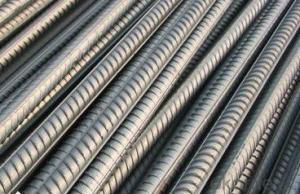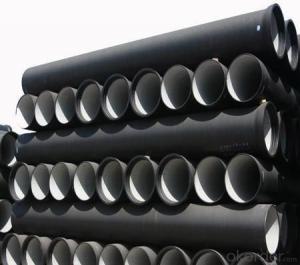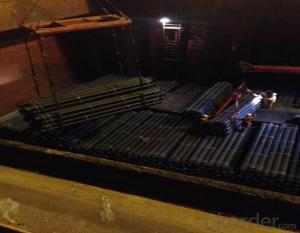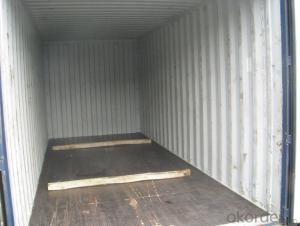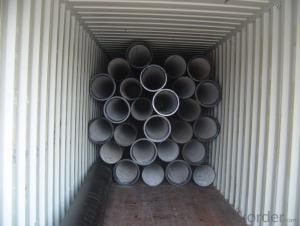DUCTILE IRON PIPES K8 DN1200
- Loading Port:
- China Main Port
- Payment Terms:
- TT OR LC
- Min Order Qty:
- -
- Supply Capability:
- -
OKorder Service Pledge
OKorder Financial Service
You Might Also Like
Ductile Iron Cast Pipe is without any defects compare with tradition casting tech, which has many advantages particularly as follow:
(1) High density. In the "vertical upward casting" process, the melt iron of centre liquid column in center crystallizer is continuously feeding for volume shrinkage caused by condensation tube at outer circumference , which lead to be free of shrinkage porosity.
(2) High purity. When melt iron pouring, the mixed impurities such as gas, dross, sand grain which are lighter than melt iron could be eliminated at furnace mouth, its impossible to enter into the crystallizer through the channel, so the melt iron into the crystallizer is very pure.
(3) Strength with toughness. The cooling speed provided by continuous crystallizer is 30 times than sand casting and 5 times than centrifugal casting, and doesn't produce white iron, the eutectic cell volume of continuous cast iron is one eighth to one tenth compare with traditional cast iron. The density of graphite nodule in ductile iron can reach 300-700 pcs/mm2. Therefore, all reason above improve the strength and toughness of continuous cast iron.
(4) Free machining. The high speed cooling make the hardening phase (such as boride, steadite) not appear like reticular, massive or thick, but diffuse like fish bone and pane in shape, moreover, there are tiny graphite flakes inlaid hardening phase. It's free machining in BrinellHardness the range of 250-300HB. However, the Brinell Hardness of 250 is top limit to common metal materials.
(5) Uniform composition of tube wall. The convection mixing of liquid column caused by marching type drawing in crystallizer make the composition of tube wall well-distributed, and concentration gradient very little.
(6) High productivity. To the wall thickness of tube under 10mm, the speed of continuous casting is 1 meter/min, to the wall thickness of tube under 20mm, the speed of continuous casting is 0.5 meter/min, which is high efficiency that centrifugal or other casting tech couldn't reach.
- Q: What are the different methods for joining ductile iron pipe?
- There are several methods for joining ductile iron pipe, including mechanical joints, flanged joints, push-on joints, and restrained joints. Mechanical joints use a rubber gasket and a series of bolts and glands to create a secure connection. Flanged joints involve bolting two flanges together with a gasket in between. Push-on joints utilize a rubber gasket and require the pipe to be pushed into the joint. Restrained joints use a combination of mechanical joints and a restraining gland to prevent movement and provide a secure connection.
- Q: Why is the sound speed of nodular cast iron lowered after heat treatment?
- This may be the material microstructure changes after heat treatment, is generally the pearlite content increased, the available change heat treatment and then check the corresponding microstructure and corresponding measuring sound velocity adjustment, such as annealing, normalizing etc..
- Q: Can ductile iron pipes be used for industrial applications?
- Yes, ductile iron pipes can be used for industrial applications. Ductile iron pipes offer excellent strength and durability, making them suitable for various industrial sectors such as water and wastewater treatment plants, chemical processing facilities, and power plants. They can withstand high-pressure conditions, resist corrosion, and have superior impact resistance, making them an ideal choice for industrial applications.
- Q: How does ductile iron pipe perform in seismic conditions?
- Ductile iron pipe has excellent performance in seismic conditions due to its inherent flexibility and strength. It can withstand ground movements and vibrations caused by earthquakes without fracturing or breaking. Its ability to absorb and dissipate energy helps prevent catastrophic failures and ensures the integrity of the pipeline system. Additionally, ductile iron pipe's corrosion resistance and durability make it a reliable choice for long-term performance in seismic-prone areas.
- Q: What are the advantages of using ductile iron pipes?
- Using ductile iron pipes in various applications offers several advantages. To begin with, ductile iron pipes possess a high strength-to-weight ratio, making them a cost-effective option for transporting fluids or gases. They can endure high internal and external pressures, ensuring the dependable and efficient transportation of materials. Furthermore, ductile iron pipes exhibit exceptional corrosion resistance. They are impervious to rust and other forms of corrosion, expanding their lifespan and reducing maintenance expenses. This makes them suitable for underground and underwater applications where corrosive elements are present. Moreover, ductile iron pipes demonstrate superior ductility, enabling them to withstand heavy external loads and impacts without cracking or breaking. This renders them less vulnerable to damage during installation or exposure to harsh environmental conditions. In addition, ductile iron pipes possess excellent flow characteristics. Their smooth inner surface minimizes friction and pressure losses, resulting in efficient fluid flow and reduced pumping costs. This is particularly advantageous in applications requiring high flow rates or long-distance transportation. Additionally, ductile iron pipes are environmentally friendly. They are produced from recycled materials and can be recycled themselves, reducing the demand for raw materials and minimizing environmental impact. Furthermore, their prolonged service life diminishes the need for frequent replacements, further reducing waste generation. Lastly, ductile iron pipes offer versatile installation options. They can be installed using various techniques like trenchless methods, which minimize disruption to the surrounding environment and lower installation costs. Their adaptability and ease of installation make them a preferred choice for various construction projects. Overall, the benefits of utilizing ductile iron pipes encompass their high strength, corrosion resistance, ductility, flow characteristics, environmental friendliness, and versatile installation options. These factors establish them as a reliable and cost-effective choice for numerous applications in various industries.
- Q: What is the expected buoyancy of ductile iron pipes?
- The expected buoyancy of ductile iron pipes is minimal due to their high density and weight.
- Q: What are the typical bedding and backfill requirements for ductile iron pipes?
- The typical bedding and backfill requirements for ductile iron pipes involve using a granular material, such as sand or gravel, to provide proper support and cushioning for the pipe. The bedding material should be placed evenly around the entire circumference of the pipe, ensuring that it is in direct contact with the bottom of the pipe and extending to a certain height above it. Backfill material, on the other hand, is used to fill the remaining space around the pipe and should be placed in layers and compacted to prevent settlement. Additionally, proper compaction and compaction equipment should be used to ensure the stability and long-term performance of the ductile iron pipes.
- Q: Are ductile iron pipes suitable for use in chemical processing plants?
- Yes, ductile iron pipes are suitable for use in chemical processing plants. Ductile iron is known for its high strength and durability, making it resistant to corrosion and capable of withstanding high pressure and extreme temperatures. Additionally, its smooth internal surface reduces friction and allows for efficient flow of chemicals.
- Q: Some questions about the bearing capacity of nodular cast iron pipes!
- The minimum tensile strength of ductile iron is 400MPa, and the stresses can be calculated according to the wall thickness, diameter and safety factor.
- Q: Are ductile iron pipes suitable for use in seismic areas?
- Yes, ductile iron pipes are suitable for use in seismic areas. Ductile iron has high strength and flexibility, making it resistant to seismic forces. It is able to withstand ground movements and vibrations during earthquakes without significant damage, making it a reliable choice for water and wastewater infrastructure in seismic areas.
Send your message to us
DUCTILE IRON PIPES K8 DN1200
- Loading Port:
- China Main Port
- Payment Terms:
- TT OR LC
- Min Order Qty:
- -
- Supply Capability:
- -
OKorder Service Pledge
OKorder Financial Service
Similar products
Hot products
Hot Searches
Related keywords










